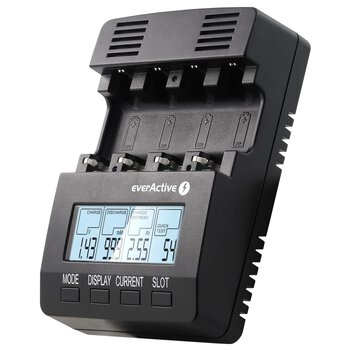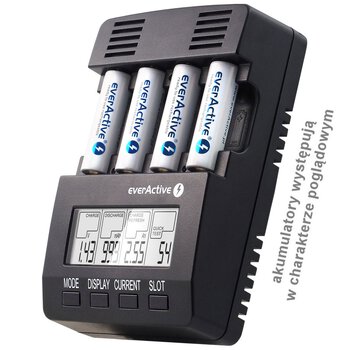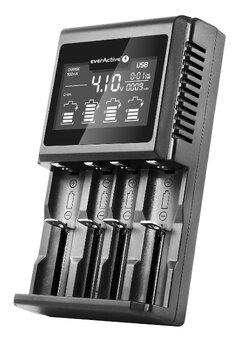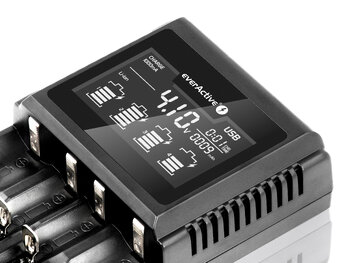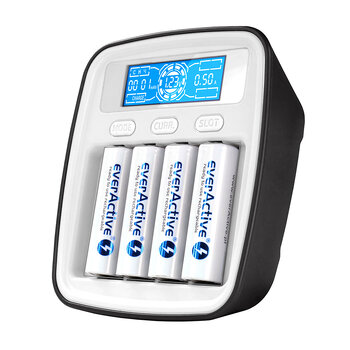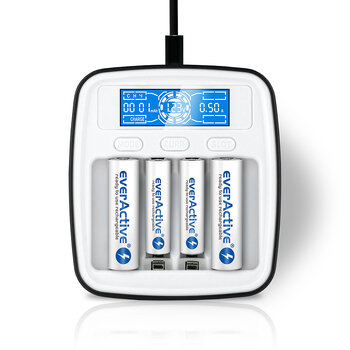- Tips
- technology
- Frequently Asked Questions
- Tests
- mAh capacity
- Rated Capacity
- everActive
- comparison
- Durability of rechargeable batteries
- Efficiency of rechargeable batteries
- battery voltage
- Accumulated energy
- Batteries vs rechargeable batteries
- LR03 AAA
- LR6 AA
- eneloop
- AG13 LR1154 LR44
- Delta V
- Charge Cycles
- internal resistance
- charge level
- CR 2032
- memory effect
- accredited test
- SR44 357
- Hearing Batteries 675
- SR626 377
- Watch Batteries
- Polarity
- Mah
- passivation
- LS 14250
- LS 14500
AA R6, AAA R03 and other rechargeable batteries made in Ni-MH technology - assessment of their charge level before use. How to interpret charging progress indicators in chargers?
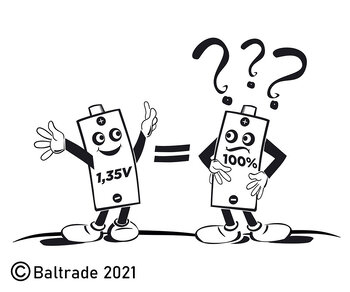
1. The voltage of a Ni-MH battery is significantly higher during the charging process than during rest or use.
When we install a discharged Ni-MH battery in any processor charger, especially a typical AA or AAA battery, its voltage after the first seconds - at the very beginning of the entire charging process - often exceeds 1.30V (and sometimes even 1.40V), especially when it was previously completely discharged to a level below 1.0V.
Charging a typical AA Ni-MH battery usually ends when it reaches a voltage of about 1.45-1.55V. This voltage varies depending on the ambient temperature (here it is worth bearing in mind the non-obvious relationship that the lower the temperature, the higher the charging voltage), the selected charging current, the manufacturer of the battery, its wear and tear, etc. - the maximum voltage reached by a Ni-MH battery is not constant and can be different each time even for the same battery, it usually becomes higher and higher as it is used - typical charging courses of a new AA (R6) Ni-MH battery are described in another article.
According to the above, chargers showing the progress of the charging process (no matter whether by graphic segments or percentages) assume that the battery, with an initial voltage of approx. 1.30V or lower, remains charged at 0%, while at approx. 1.45 it reaches ~90% charge. Here, however, there is a problem with the interpretation of these indications by users - it is quite typical when in order to check, or as a result of a mistake, we install a freshly charged (e.g. the previous day) battery in the charger and, contrary to logic, charging starts as if from "zero".
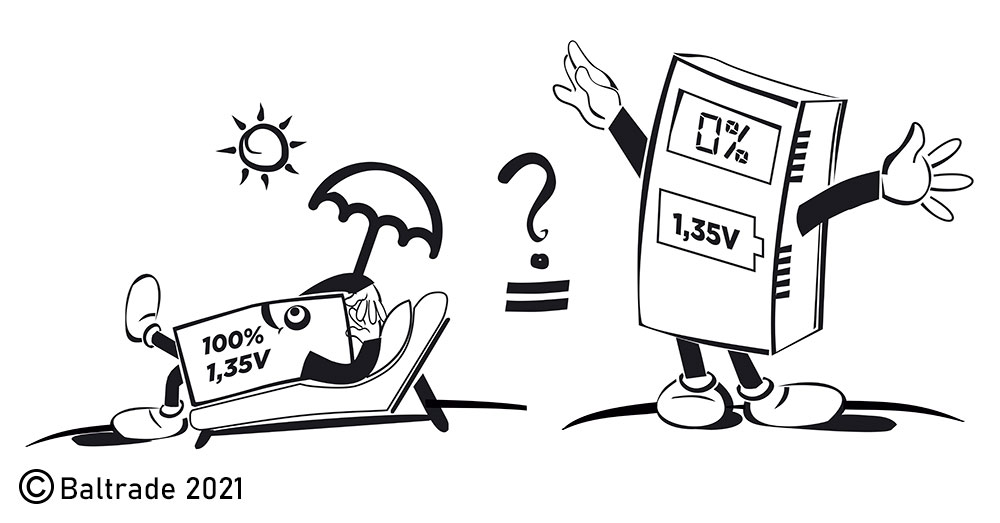
This situation is explained very well by the voltage characteristics of the Ni-MH battery. On a typical Ni-MH battery that has finished charging at 1.5V, there is a rapid, automatic voltage drop. Shortly after removing it from the charger, its voltage drops to around 1.4V. With each hour it decreases additionally, stabilizing only in the range of 1.30-1.35V - this is a completely normal phenomenon for all Ni-MH batteries. Unfortunately, the battery will behave exactly the same, where we stopped the charging process at 20% charge. It will also show a polar voltage above 1.30V for many days.
Therefore, such a battery with a voltage of 1.30-1.35V, which was fully charged the day before, when installed in even the most advanced charger, will usually be treated as discharged. As the battery charging voltage stabilizes (usually after a few minutes), the indications of the charger's charging progress will be quickly corrected, and the repeated charging process will end - usually after "charging" an additional 100-300 mAh into such a battery.
If you want to try to estimate the charge level of the Ni-MH battery directly in the charger, you should read the indication only after min. 10 minutes after charging when the battery charging voltage begins to stabilize. At the same time, we have to take into account heavily discharged batteries, where a very rapid increase in voltage during the first seconds of charging can cause a false indication of a high degree of charge.
Ultimately, this will still not be clear information that would allow us to assess how much the battery that was installed in the charger was discharged.

2. The quiescent voltage of the Ni-MH battery and the amount of capacity remaining in it.
We already know that Ni-MH batteries, due to large discrepancies and unpredictable voltage behavior during charging, cause problems with determining the charging progress even in specialized processor chargers. It is no different when we want to assess the degree of charge before use.
We can assume that a battery with a quiescent voltage measured after a few days from removing it from the charger above 1.35V will be practically fully charged.
Quiescent voltage in the range of 1.25V-1.30V is unfortunately a lottery in a sense. Depending on the type and technical condition of the battery, the time that has passed since it was charged, the time and conditions of storage, etc. This can still mean clearly above 50% charge as well as the battery is close to discharge! Unfortunately, this cannot be judged in any way based on the voltage on the battery alone.
Some battery testers measure the voltage under load - then the voltage "sits" very quickly on completely discharged batteries. However, in their case, there are still regular situations when the tester's indication is too optimistic and shows 30-50% charge for a completely discharged battery.
The only thing that is almost certain is that AA batteries, as well as AAA batteries with a quiescent voltage below 1.25V, will need to be charged - in their case there is a high probability that they are close to discharge.
3. Conclusions, advice.
To sum up, in the case of Ni-MH batteries, we will not be able to quickly and accurately check the current state of charge, and the percentage or graphic indications in the chargers only show the approximate progress of a given charging process.
The only sure way to assess the current charge of a Ni-MH battery is to discharge it (the everActive NC-1000 Plus, NC-3000 and UC-4000 chargers have the appropriate mode). Unfortunately, for a typical user, this will not be a solution, because it is usually a quick assessment of whether a given battery can still be used or already needs to be recharged.
Answering numerous questions from our readers and customers, I recommend recharging batteries with an initial voltage of 1.25V and lower, while in the case of batteries with a quiescent voltage of about 1.28V and higher, if we know that the batteries were previously fully charged, we can assume with high probability that they still have a high remaining capacity and do not necessarily need to be recharged.
The voltage range of 1.26V-1.27V is the most difficult to evaluate. In this regard, we usually do not know whether the battery has 20% or maybe 70% of its available capacity, and thus, to avoid unpleasant surprises, it is also better to charge such batteries before use.
The same applies to new, freshly purchased batteries (even if they are new generation batteries, ready to use (lsd / ready to use) with a voltage of 1.26V or higher).
Even new, branded and most reliable AA and AAA batteries (R6 and R03), despite the manufacturer's assurance that they are ready for use, we also recommend charging them fully before the first use - in their case we can never be sure when (how long ago) they were charged and we do not know if they are still equal - with the same level of initial charge.
Author: Michał Seredziński
Copying the content of the article or its part without the consent of a representative of Baltrade sp. z o.o. is prohibited.
Popular battery chargers in the hurt.com.pl store
Charger everActive NC-3000
Processor with discharge and measurement of capacitance and a unique test of internal resistanceof the cell,
function of refresh, maintenance, battery formation,
Min. Charging time 4 batteries 2500mAh-3h.
Processor, Ni-MH, Ni-Cd, 1-4x R6/AA, R03/AAA, 1-2x R14/C, R20/D using optional adapter
12V DC Input voltage-AC adaptor included, optional car adaptor available
2 years Warranty
Charger for Li-Ion and Ni-MH rechargeable cylindrical batteries everActive UC-4000
Rechargeable battery charger Ni-MH everActive NC-1000M
-
Mam pytanie Czy ktoś mi może odpisać jakim napięciem powinienem ładować 10 akumulatorków AA wraz chodzi o to że mam ręczne CB radio na 10 akumulatorków AA mam tam wtyk do zasilania oraz wtyk do ładowania. Jaka ładowarka będzie odpowiednia ile volt musi dawać. Średnia pojemność każdego z akumulatora to około 1000 mAh NiHm. Próbowałem podłączyć ładowarkę 14,6 v 2A i wydaje mi się że nie doładowuje. Mylę się Czy nie?
-
Akumulatorki Ni-MH są pod tym względem o tyle charakterystyczne, że nie mają jednego stałego napięcia ładowania, na podstawie którego moglibyśmy określić, że zostały do pełna naładowane. Im niższa temperatura otoczenia/samego akumulatora, im bardziej wyeksploatowany jest akumulatorek, wreszcie im wyższy jest prąd ładowania tym to napięcie staje się coraz wyższe. Potrafi się ono nawet nieco różnić nawet między nowymi akumulatorkami z tej samej partii.
Wracając do opisywanego problemu/pytania.
Jeżeli mamy 10 akumulatorków Ni-MH połączonych szeregowo, o pojemności 1000 mAh każdy, to mamy wynikową baterię o nominalnej pojemności 1000 mAh i napięciu nominalnym 12V.
Aby ją poprawnie i względnie bezpiecznie naładować prostym zasilaczem, to potrzebujemy doprowadzać do niej 100 mA prądu przez 14-16h, lub ew. nieco krócej, 200 mA przez ok. 6-6.5h. Maksymalne napięcie ładowania tej baterii może zawierać się w zakresie ok. 14.8-15.5V.
Wspomniane 14.6V będzie prawdopodobnie napięciem zbyt niskim (no chyba, że to stary zasilacz transformatorowy bez stabilizacji napięcia), a z kolei natężenie 2A byłoby za wysokie przy ładowaniu takiego pakietu bez dodatkowej kontroli/automatyki. Także jak chcemy próbować tym sposobem, to potrzebujemy zasilacza o napięciu 15V lub wyższym z ograniczonym prądem wyjściowym do maks. 200 mA. Nadać powinien się odpowiednio dobrany stałoprądowy zasilacz "ledowy" np. 8.4W 200mA 9-42VDC.
Zwykłe, tradycyjne stałonapięciowe zasilacze mogą się tutaj nie sprawdzić - typowy zasilacz nawet taki opisany jako 15V 200 mA, może pracować wyraźnie powyżej swoich nominalnych parametrów (będzie przeciążany) przy wymuszonym dużo niższym napięciu rozładowanego pakietu baterii. Z kolei przy wyższych prądach ładowania, bez zastosowania dodatkowych mechanizmów bezpieczeństwa łatwo możemy doprowadzić do przeładowania i przegrzania takiego pakietu baterii.
-
